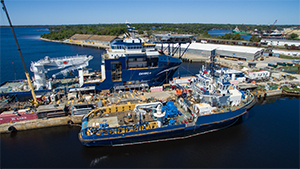Harvey Gulf International Marine’s new tugboat could be overlooked amid a steady newbuild program of sophisticated oil field support vessels and the first LNG fleet of OSVs in the U.S.
But Harvey Stone, a 212-foot, Tier 4 multi-purpose field support vessel (MPFSV) delivered in early May from Eastern Shipbuilding of Panama City, Fla., is impressive.
“It’s a unique little vessel,” said Chad Verret, Harvey Gulf’s executive vice president for Alaska and LNG operations. “Well, not so little.”
Harvey Stone may be small compared to the behemoths Verret has piloted through the design, regulatory and construction phases for deepwater oil support in recent years, but it is big in vision. The hybrid tug is believed to be the first Tier 4 tugboat built and operated in the U.S.
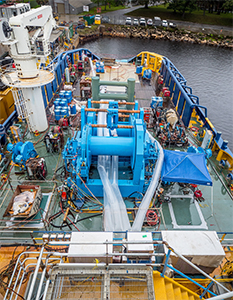 |
|
Harvey Stone has a MacGregor anchor-handling and towing winch and MacGregor 10-ton hydraulic knuckle boom crane. |
Some time ago, Shell Oil sought builders for an offshore tugboat designed to support lightering operations at the company’s floating production storage and offloading (FPSO) site at Shell’s Stones deepwater project in the Gulf of Mexico. Operating in 9,500 feet of water, it is the deepest production facility in the world. This prospective vessel also would act as a safety standby vessel over the course of a long-term contract.
There were a half-dozen contenders for the contract and a few, including Harvey Gulf, presented similar designs.
“But we were the only one that had specced a hybrid vessel because we both (Shell and Harvey Gulf) wanted a highly efficient and environmentally friendly design,” said Verret.
Safety and the environment have risen to the forefront of Harvey Gulf’s operations and vessel design under CEO Shane Guidry. No stranger to being the first, Harvey Gulf built the first LNG fleet of OSVs in the country and also constructed the first marine LNG fuel station in the U.S. at Port Fourchon, La.
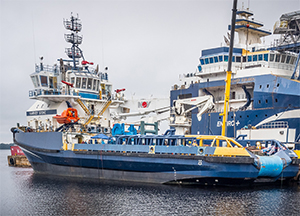 |
|
The 212-foot Harvey Stone undergoing final preparations in mid-April. |
Verret and James McCarthy, senior naval architect at Robert Allan Ltd. (RAL) of Vancouver, B.C., worked together to meet Shell’s requirements.
“The main design and classification challenges were the multiple roles that had to be accommodated in order to meet the requirements of the Shell specifications,” McCarthy said.
The result is a RAmpage 6400 design, the largest of RAL’s RAmpage class of offshore support tugs. It is also the first of the class with a sponson hull, similar to RAL’s RAstar escort tugs, to enhance its sea-keeping ability, McCarthy said. The sea-keeping characteristics of an MPFSV operating at Shell’s Stones Field are important because the vessel must perform berthing operations in 30 knots winds, waves exceeding 8 feet and currents reaching 2 knots. During those challenging conditions, Harvey Stone also must perform pull-back operations on the shuttle tanker in winds up to 40 knots.
Harvey Stone, as the dedicated pull-back support and assist tug for massive lightering tankers, will act as the escort tug for Shell’s 900-foot Turritella FPSO during a hurricane avoidance operation. The tug also is the contract towing vessel in the event of a mechanical breakdown on the FPSO during transit.
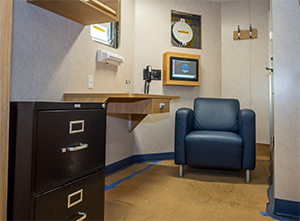 |
|
The well-appointed crew quarters aboard Harvey Stone are designed for maximum comfort during weeks at sea. |
“As required by the specifications, and due to the fuel capacity, the vessel is double hulled,” said McCarthy. “And all fuel, oil and sewage are segregated from the hull.”
In addition, Harvey Stone complies with the Gulf of Mexico Emergency Evacuation Plan, with aircraft seating for 120 people, in addition to the crew, in the event of an emergency, and is classed FiFi-2.
“The vessel is fitted with an off-ship firefighting system to Class FFV2 system requirements,” said McCarthy. This system offers significantly more firefighting capacity than a standard FFV1 vessel, he noted. PTI/PTO clutches on the front of each main engine drive the FFS fire pump system with FFS monitors.
After looking at different propulsion systems that would meet Tier 4 emissions standards, Harvey Gulf chose GE 250 series Tier 4 marine diesel engines.
“We went with a Tier 4 design that doesn’t use urea,” said Verret. “Then we took it a step further.”
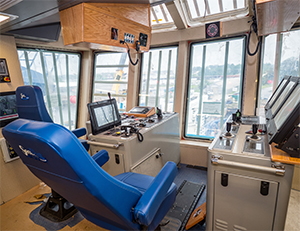 |
|
The bridge deck on Harvey Stone has a modern electronics and navigation suite. |
When the vessel is on standby, it still must maintain position inside the area of operations. The question became, “How to have the vessel maintain (dynamic positioning) in a light load mode while still being efficient,” said Verrett. “And that’s when we came up with putting motor generators on each gearbox.”
The motor generators allowed the tug to utilize one main engine to maintain station and provide electrical power for the tug when it is on standby. “And when you look at the whole design, that was a very efficient way of achieving it. None of the other bidders offered that.”
The hybrid electro-mechanical propulsion system driving Harvey Stone consists of the two GE engines at 4,694 hp each, connected to Reintjes LAF 3414P HL marine gears shafted to 1,000-kW variable-speed motor generators. These generators are connected to a DC bus via variable frequency drives. At the stern are two Schottel SRP 3030 CP propellers in nozzles. The bollard pull is 106 metric tons.
Direct diesel mechanical propulsion power is provided by the main engines, and the electrical power is provided by the shaft motor/generators. These generators provide power to two bow thrusters.
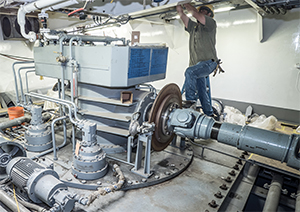 |
|
Schottel model SRP 3030 z-drives provide propulsion and steering for the 212-foot vessel. |
“The hybrid system is configured with a dual output/input gearbox driving the propulsion shaft line on one side and the motor/generator on the other,” McCarthy said. “Since the vessel will see a large percentage of time at a loitering condition while on station, it is more economic to utilize a single main engine to drive all propulsion units and house loads.”
For more precise stationkeeping, Harvey Stone is equipped with two Schottel STT 2 fixed-pitch transverse bow thrusters driven by 600-kW electric motors. Two 350-kW Cummins QSK19-DM Tier 3 gensets supply the ship’s service power and there is a Cummins CMSL QSB-DM 120-kW emergency generator.
Versatility is a strong suit for Harvey Stone. The vessel carries equipment and electronics to conduct ocean towing, rig towing, anchor-handling, ship assist and cargo transfer operations.
For ocean towing and anchor handling, Harvey Stone has a huge MacGregor double-drum hydraulic waterfall winch with 1,500 meters of 76-mm wire on the stern deck. On the bow there is a MacGregor hawser winch with 1,500 meters of synthetic line for ship-handling.
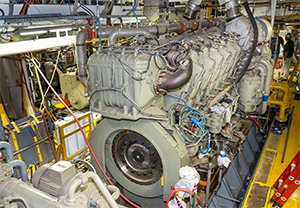 |
|
Two GE Marine 12V250 Tier 4 diesel engines each producing 4,694 hp at 1,000 rpm power Harvey Stone. The vessel is believed to be the first Tier 4 tug at work in the United States. |
The transit distances from Gulf Coast ports to deepwater wells favor vessels capable of carrying cargo and rated DP to accommodate cargo operations efficiently and safely. Time and deck are money. Harvey Stone has 2,690 square feet of aft deck for transporting containers and equipment. There is also tank storage for fuel and potable water. The vessel’s “ROV Capable” notation allows it to conduct diving operations for the maintenance and inspection of the floating hose. The vessel also has the ability to perform some anchor-handling duties.
Harvey Gulf met most of Shell’s requirements, but some were not practical, given the vessel’s size and format. For example, a morgue proved unnecessary because the area of operation is within 20 hours from a port of safe haven. ”But we put all the other comforts in there such as seating and accommodations,” Verrett said.
Along with other design challenges, special attention was paid to reduce noise and vibration. This was accomplished by installing isolation mounts on the main engines, system silencers and a specialized flooring system.
A few weeks before delivery, England Reeves, project manager for Eastern Shipbuilding, oversaw vendors, contractors and shipyard workers pushing to finish the vessel. “The most challenging aspect of the project has been the development of the hybrid power and propulsion system,” he said. “Coordinating between the many suppliers, ABS, testing authorities and USCG has proven to be quite the challenge.”
Verret attributed the success of the project to engaging with key partners such as Shell, Robert Allan Ltd., Eastern Shipbuilding, ABS and the Coast Guard to solve problems as they arose. The result is a first-of-its-kind vessel ready to work the deepwater oil fields.
“It’s a pretty unique tug,” Verret said. “It’s unique because we met a requirement with a lot of notations that are not typical. But we’ve addressed all the issues during multiple sessions with all of the partners.”

